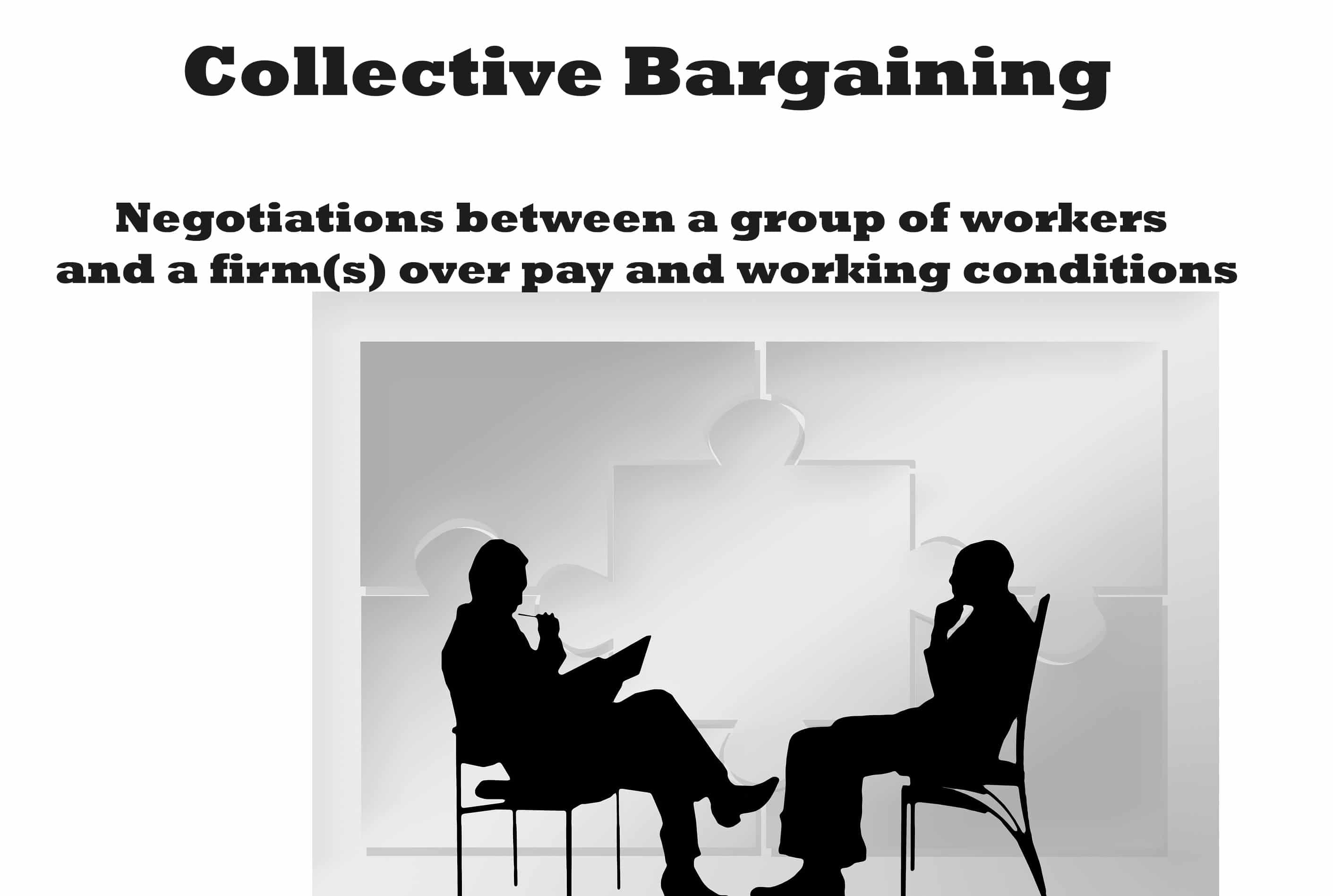Explain Different Types of Collective Bargaining
Different Techniques of collective bargaining are as follows. I Distributive bargaining - Also termed as conjunctive bargaining this form of bargaining aims at re-distribution of benefits between the management and the group of workers.

Collective Bargaining Meaning Types Theories Importance
The collective bargaining mainly comprises of 4 types of activities.

. Types of Collective Bargaining Conjunctive Distributive Bargaining. The right-to-manage model developed by the British school. October 5 2020 in Business and Finance Assignment Help by Joseph.
Collective bargaining agreements will usually result in a higher level of pay for a worker. Both the parties try to maximize their respective gains. You can be creative in how you demonstrate your knowledge about the topic you choose.
The purpose is to reach an agreement to regulate the working conditions. Ii Integrative bargaining - Also termed as co. Of recent is the right to.
Explain various perspectives of collective bargaining theories. Be sure to also include an introduction. Different economic theories provide a number of models intended to explain some aspects of collective bargaining.
They try to settle economic issues such as wages benefits. I Distributive bargaining - Also termed as conjunctive bargaining this form of bargaining aims at re-distribution of benefits between the management and the group of workers. Collective bargaining is a tool used to solve workplace problems.
Ad Over 27000 video lessons and other resources youre guaranteed to find what you need. Collective Bargaining Top 4 Types. Mandatory permissive and illegal.
Broadly collective bargaining can be categorized into four types. The stages of collective bargaining are preparation. Wages health and safety management rights work conditions and benefits fall into the mandatory category.
This is the type in which one side wins and the other team loses completely. A collective bargaining process generally consists of four types of activities. The so-called monopoly union model Dunlop 1944 states that the monopoly union has the power to maximize the wage rate.
Negotiation is a process in which two or more parties discuss specific offers with a view to reach a mutually acceptable agreement. Types of collective bargaining. Based on this there are five essential forms of collective bargaining.
Collective bargaining refers to a process of negotiations between the employer and employeeregarding work conditions wage rates and any other worker related issue. Types of Bargaining Strategies in Negotiation and Conflict Distributive Bargaining Strategy. You can use links in the presentation graphics case law videos etc.
Permissive topics are those that are not required but may be brought up during the process. This may occur when the employer and union representative have a good working relationship that enables them to continually make small changes to ensure positive employment policies. Collective bargaining allows workers to band together into larger groups create a louder voice that can help provide one another with a mutually beneficial outcome.
It is zero-sum negotiation in which one party have to suffer loss and the other party will gain. The sole objective of this negotiation is to arrive at an agreement between workers and employers thus cementing effectiveness efficiency and productivity in the workplace. The negotiation that seeks one or.
In co-operative bargaining both parties realise the importance of surviving in difficult. Distributive bargaining is the most common type of bargaining involves zero-sum negotiations in other words one side wins and the other loses. Collective bargaining is a device of selling the services of union members in the best possible market and at the highest possible price.
There are three main classification of bargaining topics. In this type of bargaining the employers and employees try to maximise their respective. Although trade unions insist on preserving the free enterprise system and maintaining competitive controls in labour markets many of the techniques used in collective bargaining.
Distributive bargaining is defined as negotiations that seek to divide up a fixed. Collective Bargaining refers to the process of discussion in which the representative of employees and management determine the employees wages and benefits. Both parties try to maximize their respective gains.
This kind of collective bargaining is concerned with the employee and the employer who negotiate with each other but for their own gain only. Distributive or conjunctive bargaining. Continuous bargaining is a method of collective bargaining in which ongoing negotiations between the employer and the union representative take place.
It is the most common type of bargaining and involves zero-sum negotiations in which one side wins and the other loses. Distributive Integrative Attitudinal Restructuring and Intra-Organizational Bargaining. This type of collective bargaining in walls zero-sum negotiations and is considered as the most common type of bargaining.
In this form of bargaining one group gains while the other looses something. You will highlight seven different areas of collective bargaining that you will explore. The goal is for you to explore areas that interest you and for you to explain them in more depth.
Types of Bargaining 1. In this form of bargaining one group gains while the other looses something. The firm then chooses the level of employment.
Collective agreement is the result of the process of collective bargaining. Collective bargaining can improve a workers quality of life. Collective Bargaining 4 Important Types.
Types of Collective Bargaining Conjunctive or Distributive Bargaining. Attitudinal restructuring and.

Collective Bargaining Definition Explanation Types Economics Help

11 Things Required For Collective Bargaining Succeed Googlesir

Unit 7 Collective Bargaining And Negotiation Negotiation Collective Bargaining Ppt Download
No comments for "Explain Different Types of Collective Bargaining"
Post a Comment